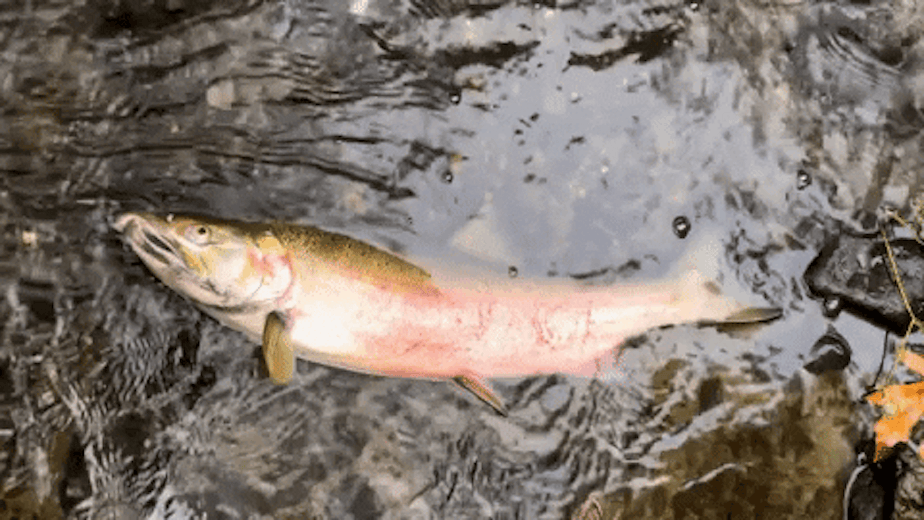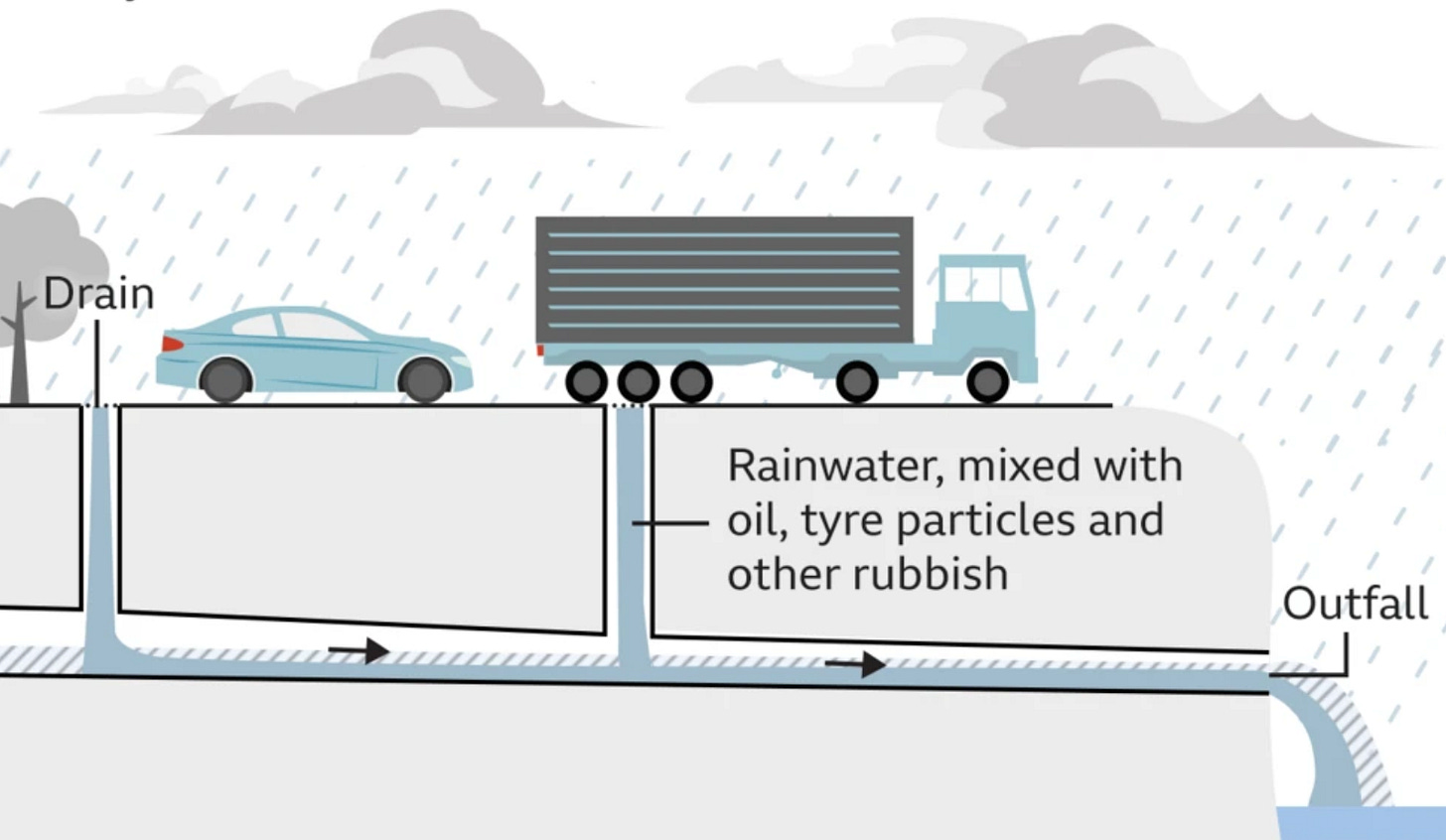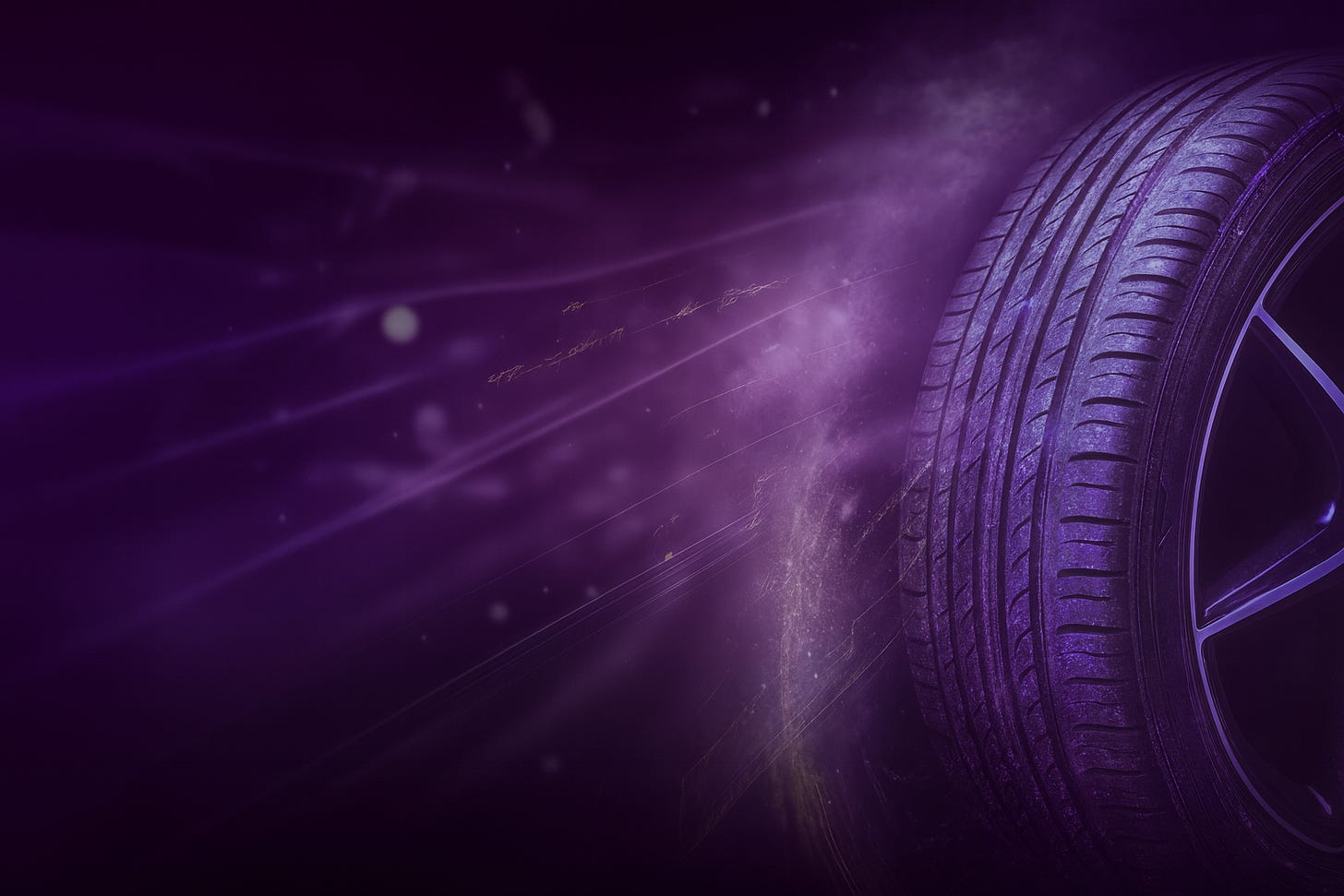The Tyre Poison Nobody Talks About
Salmon die within hours of storms. New science shows the same dust drifts into cities and lodges in human lungs.
When rain hits city streets, salmon die within hours. Scientists have traced the killer to a chemical hidden in every car tyre, one that turns stormwater into poison. New research shows this dust doesn’t just wipe out fish, it rides the air, lodges in our lungs, and is already reshaping ecosystems worldwide.
In Seattle’s Longfellow Creek, volunteers once counted the return of salmon each autumn like a ritual. The sight of silver flashes pushing upstream through an urban stream felt like a miracle, a reminder that wildness still pulsed in a city of glass and concrete.
Then came the rain. Heavy drops slammed the streets, flushing water off tarmac into drains, then into creeks. Hours later, the salmon that had made it home from the Pacific began to twitch, spiral and float belly-up. Some with eggs spilling from their bodies. Whole runs gone overnight.
For decades, no one knew why. The water wasn’t poisoned by oil or sewage. Metals were present but not at lethal levels. Yet the salmon kept dying. It felt like watching a ghost, fish appearing strong and healthy, only to collapse as if the rain itself had turned toxic.
It had.

A Secret Inside Every Tyre
Every car tyre is a black box of chemistry, more than 400 ingredients blended in proprietary recipes. Carbon black. Vulcanising agents. Heavy metals. Antioxidants that keep rubber from cracking.
One additive, 6PPD, turned out to be the killer. Tyre makers use it to stop rubber cracking in sunlight. In the air there’s a gas called ozone (you may have heard of the ozone layer that protects us from UV rays). Ozone is a form of oxygen, but with three atoms instead of two, and it’s so reactive it attacks rubber. 6PPD reacts with it first, sacrificing itself to protect the tyre. The problem is that this reaction creates a new chemical, 6PPD-quinone. When rain washes that into streams, it becomes deadly to salmon. Until recently, nobody had studied it at all.
In 2020, Tian and Edward Kolodziej’s team at the University of Washington identified it as the invisible assassin. When coho salmon were exposed to stormwater containing this compound, fish died in less than three hours.
The mystery was solved, but the story doesn’t end with salmon. It’s about to reach your car, your street, and your lungs.
A huge thank you to Founding Members and paid subscribers, you make this work possible and keep it free for those who need it most.
New pieces go to paid subscribers first, opening to all readers after two weeks. If you’re on the free list, this is where your preview ends. To keep reading today, and support free access for others, please consider a paid subscription.
The Black Dust Under Your Car
This isn’t abstract. You can touch it.
Next time you walk to your car, crouch down and swipe your finger under the wheel arch. That black grime you pick up? A mix of road grit, brake dust, and tyre particles laced with 6PPD.
Every rotation of your tyres shaves off fragments. Most are invisible, smaller than the width of a human hair, some fine enough to slip into lungs. Some settle in thick crusts under wheel arches. Either way, they are waiting to be carried into rivers, lungs, or oceans.
The Unlucky Species
Not all salmon respond the same way. Coho are the most vulnerable. Expose them to untreated urban runoff and mortality is near total.
Steelhead and Chinook also die, though less consistently. Sockeye often survive. In 2024, a Norwegian study led by Anders Foldvik found pink salmon fry could tolerate levels of 6PPD-quinone lethal to coho.
The variability matters. It means the compound isn’t a universal hammer, but it strikes a fatal blow against certain species. Unfortunately, those species, like coho, are already struggling from habitat loss and climate stress. 6PPD-quinone is another nail in the coffin.
The Elephants in the Air
Tyre dust is not just a river problem. It’s airborne.
In 2025, a study led by Hye-Min Yoo in Seoul found over 61,000 kilograms of tyre and road-wear particles drift into the air every year. That’s the weight of ten elephants floating through the city as invisible dust. Each particle is fine enough to lodge deep in human lungs and never leave.
Globally, OECD analysis shows that in many cities, non-exhaust emissions from tyres and brakes already exceed tailpipe emissions. Tyres shed an estimated 3 million tonnes of particles globally each year, roughly the weight of every human in the UK combined.
A Lived Moment
Walk along any busy road and you’re breathing the same chemistry that kills salmon in creeks. I felt it most sharply one wet afternoon, pushing my son Finlay’s pram along a main road. Trucks roared by, spraying oily mist.
Every inhale made me think of salmon gills flaring under stormwater, seizing in chemical shock. The same dust coating their gills is entering my son’s lungs. His first years on Earth are marked by the quiet inhalation of tyre wear, a legacy he never chose.
Salmon as a Mirror
This is why salmon matter. Not only because they are iconic fish, or because Indigenous nations revere them, or because ecosystems depend on them. They matter because they are showing us what our world is turning into.
If coho die within hours of exposure, what does slow, chronic exposure mean for us? Tyre dust contains phthalates, chemicals known to disrupt hormones and reduce fertility. Animal models show tyre microplastics inflame lungs and damage immune systems.
A 2025 review in Environmental Toxicology and Chemistry concluded that tyre-derived dust is “a probable risk factor for human respiratory and endocrine health.”
The salmon are not dying instead of us. They are dying first.
In June 2025, a new study led by Zhenyu Tian confirmed that tyre-wear particles ripple outward, also disrupting trout, aquatic insects, and even the microbial base of river ecosystems. What began as a local puzzle in a Seattle creek is now understood as a global chemical footprint of modern life.
Policy Cracks Begin to Show
Governments are finally waking up.
In 2025, the US EPA listed 6PPD-quinone as a high-priority toxic substance.
In 2023, California designated tyres containing 6PPD a “Priority Product,” forcing the industry to find safer alternatives.
The European Union will impose the first-ever limits on tyre abrasion under its Euro 7 standards in 2025. The Netherlands and Austria are lobbying to restrict 6PPD outright.
Communities aren’t waiting. In 2023, U.S. fishing groups sued tyre manufacturers, arguing that 6PPD is wiping out salmon and steelhead runs that sustain their livelihoods. The case echoes climate lawsuits against oil giants: companies knew, or should have known, the risks of their products.
That same year, a coalition of tribes petitioned the EPA to ban 6PPD from tyres entirely, citing its threat to salmon, steelhead, and treaty-protected fishing rights. For communities that have lived with salmon for millennia, the chemical is not an abstract pollutant, it is an existential attack on culture, food, and survival.
Tyre companies cannot hide behind trade secrets forever. The science is clear: 6PPD-quinone kills salmon. At a minimum, manufacturers must commit to phasing out 6PPD on a fixed timeline, fund independent toxicology studies into alternatives, and open their chemical recipes to regulators instead of lobbying for secrecy. They should invest in stormwater solutions where their products cause the most harm, and stop treating salmon deaths as collateral damage. Every mile driven is shredding rubber into dust, much of it laced with toxic chemistry.
Change is slow. Alternatives exist, such as lignin-based antioxidants, but scaling them up takes investment the industry resists. For now, every car on every road carries the same hidden chemistry.
A Final Thought
We can trap some particles in storm drains with filters, wetlands, or green infrastructure. Street trees can help.
Yet as long as we build cities around two-tonne machines, our lungs become the landfill for their dust. Every trip to the shop, every school run, every delivery truck grinds rubber into fragments that don’t vanish. They circulate through rivers, soil, oceans, and bodies.
A coho salmon thrashes in black water. Its gills clog, eyes bulge, muscles stiffen. A fish that survived predators, nets, and ocean storms dies in minutes in a city creek.
The dust that kills salmon in minutes is already in my son’s lungs.
Further Reading
Foldvik et al. (2024) — Environmental Toxicology and Chemistry
Yoo et al. (2025) — Environmental Toxicology and Chemistry
OECD (2020) — Non-exhaust particulate emissions
California DTSC (2023) — Tyres with 6PPD
European Environment Agency (2024) — Euro 7 standards







This is appalling, terrifying and heartbreaking. We must all pass this along to educate others and get involved. Thank you so much all the work you do for our world, Like.